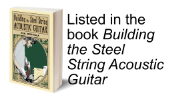Ipomoea Acoustic Guitar
The Ipomoea is a modern small bodied steel string acoustic guitar. It features an OM size body (15" across the lower bout) with a pinless bridge and a soundhole offset into the upper bout. The guitar has a fully removable bolt-on neck and a Florentine cutaway. The top features a simplified "A" bracing pattern, as found in the Tinozza acoustic bass guitar and originally borrowed from the very nice line of instruments from Tacoma. Combined, these features yield a comfortable instrument with good volume; an even, mellow, jazzy tone; and a very modern look and feel.
Design goals for this instrument include good tone and volume, ease of maintenance, and somewhat simplified construction. I also wanted to design an instrument that could produce world class tone when built by a knowledgeable luthier but that would not be too formidable a project for the lutherie beginner. The simplified bracing and bolt-on neck do help to make this a more straight forward construction project. And the size of the instrument and the bracing pattern yield very good tone and acoustic volume.
Initially appeared: June 2, 2009
Last updated:
July 02, 2025
About the Instrument
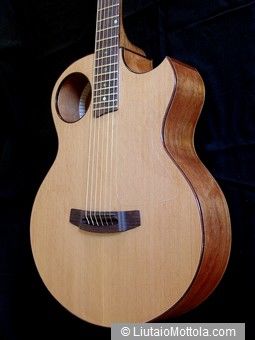
The Ipomoea acoustic steel string guitar is a modern small-bodied instrument. Designed specifically for fingerstyle jazz, it has a scale length of 25.5" and the neck meets the body at the 14th fret. Neck dimensions and string spacing follow the conventions of most modern electric guitars, making this an ideal acoustic instrument for the electric player. The fingerboard radius is 12". The body is 15" wide at the lower bout. Body depth and length are also typical of guitars of this size. Less conventional features of the instrument include a pinless bridge, offset soundhole, clear plastic pickguard and nut and saddle made of black phenolic.
The sides and back of the instrument shown are constructed from Honduras mahogany. The top is red cedar and the internal braces are spruce. The bolt-on sapele neck has an adjustable trussrod. The fingerboard and fittings are made of Indian rosewood. The fully removable neck is fitted to the body using two bolts, in the style of (older) Taylor guitars, and the fingerboard extension is bolted to the top using a single screw.
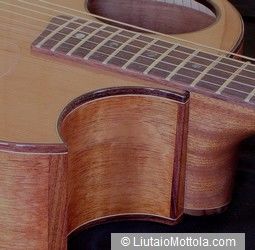
The top uses a simplified bracing pattern similar to that of the great sounding Tacoma instruments. The Ipomoea employs two longitudinal bars and one transverse bar. The transverse bar is just in back of the bridge. There is a thick (1/2") patch connecting the transverse bars at the point where the fingerboard ends. This is used to support the screw that attaches the fingerboard extension. There is also a soundhole reinforcement patch made of 3mm birch ply. Although the bridge is pinless, there is a bridge plate, also made of 3mm birch ply.
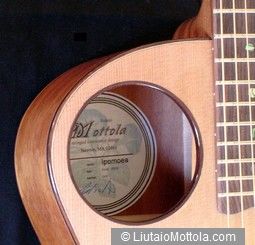
The sound hole is located in the upper bout. Most of the time when this sound hole position is used the claim is made that this increases the acoustic volume of the instrument by increasing the vibrating area of the top. Interestingly enough, there has never been any formal research to support this hypothesis. The sound hole is located here in the Ipomoea guitar primarily so the simplified bracing pattern can be used. This location also does lower the Helmholtz resonance a bit, too, which provides a little more bass than is typical of instruments with small bodies.
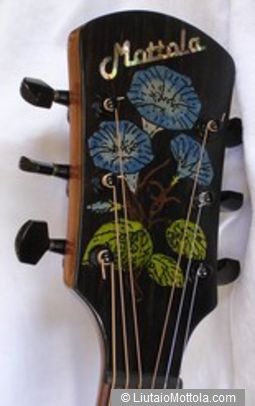
Ipomoea is the Italian word for morning glory. I decorate the headstock with a morning glory motif. The flowers are inlaid pieces of maple which are routed with thin lines. These are filled with black mastic and sanded back, and then the flowers are painted by hand using water based aniline dyes.
Construction
The downloadable copyrighted instrument plan is made available for non-commercial use only and may not be redistributed.
 Download Full Size (36"x48") Ipomoea Acoustic Guitar
Plan (.pdf)
Download Full Size (36"x48") Ipomoea Acoustic Guitar
Plan (.pdf)
Construction of the instrument is fairly typical of flattop steel string guitars, but there are a few things unique to this instrument and its features that should be kept in mind when contemplating a build. Most of these involve the bracing of the plates, the construction of the bolt-on neck, and the pinless bridge.
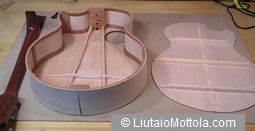
Bracing of the Back -
I have been observing that the backs of many guitars are too stiff for optimum sound, and have been reducing brace height in my instruments accordingly. In this small bodied instrument I opted to use just three back braces rather than the usual four. It works out well - stiffness is reduced, tone is improved, and there is one less brace to make and install.Bracing of the Top -
The picture above and its enlargement show the details of the top bracing.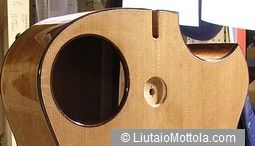 The two longitudinal braces are let into slots in the neck block. There is a thick block that joins these two braces, positioned at the end of the fingerboard extension. In the finished instrument a hole is drilled through this block for the screw which attaches the fingerboard extension. A recess (pocket) is drilled into this block from the outside of the instrument to provide clearance for the threaded boss on the underside of the fingerboard extension.
The two longitudinal braces are let into slots in the neck block. There is a thick block that joins these two braces, positioned at the end of the fingerboard extension. In the finished instrument a hole is drilled through this block for the screw which attaches the fingerboard extension. A recess (pocket) is drilled into this block from the outside of the instrument to provide clearance for the threaded boss on the underside of the fingerboard extension.
The longitudinal braces join a single transverse brace positioned just behind the bridge. Carving of all of the braces is shown in the picture. Note also the soundhole reinforcement patch, made of 3mm Baltic birch ply, and the bridge plate, made of the same material.
Bolt-on Neck -
A conventional butt joint two bolt neck joint is used, in the style of the early Taylor guitars and lots of others.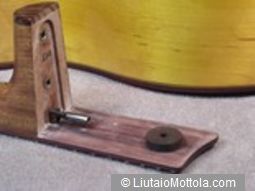 As mentioned above, the fingerboard extension is also bolted on, resulting in a completely removable neck. A wood or phenolic boss with a threaded hole is glued to the underside of the fingerboard extension. The extension is bolted on from the inside of the instrument.
As mentioned above, the fingerboard extension is also bolted on, resulting in a completely removable neck. A wood or phenolic boss with a threaded hole is glued to the underside of the fingerboard extension. The extension is bolted on from the inside of the instrument.
Pinless Bridge -
The Ipomoea guitar features a pinless bridge. Although conventional yellow woodworking glue provides more than enough strength in this application, it should be noted that glue strength specifications are usually based on solidly constructed glue joints. Care should be taken when preparing the bridge and top for gluing on the bridge to achieve a solid bond. Proper clamping while the glue dries is also a must.
Although conventional yellow woodworking glue provides more than enough strength in this application, it should be noted that glue strength specifications are usually based on solidly constructed glue joints. Care should be taken when preparing the bridge and top for gluing on the bridge to achieve a solid bond. Proper clamping while the glue dries is also a must.
The bridge is constructed with six anchor holes drilled partway through into the back side of the bridge. Each anchor hole contains a small brass washer, glued in, which keeps the string ball from chewing up the inside of the hole. A smaller diameter string hole is drilled further into the bridge inside each washer hole. These let into a well which is excavated into the bridge from the top. The floor of the well is flat and the back and ends walls are perpendicular to it. But the front wall slopes up to the top of the bridge to provide more support for the saddle slot.




 This guitar has been quite popular among guitar builders, some of whom have come up with a number of interesting modifications to the basic plan. Neville Jenkin did a beautiful job on a straight ahead version. Check it out.
This guitar has been quite popular among guitar builders, some of whom have come up with a number of interesting modifications to the basic plan. Neville Jenkin did a beautiful job on a straight ahead version. Check it out.
